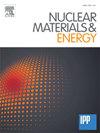MAST升级中强挡板导流器辐射剖面的演变
IF 2.7
2区 物理与天体物理
Q1 NUCLEAR SCIENCE & TECHNOLOGY
引用次数: 0
摘要
在未来的托卡马克中,等离子体分离是充分降低目标热流的必要条件。它涉及等离子体与杂质和中性粒子的相互作用,导致等离子体功率、动量和粒子的显著损失。对分流器和x点区域的等离子体发射率进行精确测绘,对于定位和推断影响剥离过程的功率损耗至关重要。最近在must - u (Federici et al., 2023)中验证的红外视频辐射热计(IRVB)诊断使这种映射具有比电阻辐射热计等更成熟的方法更高的空间分辨率。在之前的初步工作中(Federici et al., 2023a),辐射脱离目标(辐射脱离)以l模式表征(进入刮擦层的功率,PSOL ~ 0.4 MW)。使用常规分流器时,内腿始终先于外腿脱离,辐射脱离先于颗粒通量脱离。这项工作还展示了第三次MAST-U实验活动的结果,从低场侧而不是高场侧提供燃料,包括欧姆和光束加热的l模射击(核心输出功率高达PSOL ~ 1-1.5 MW)。在较低的上游密度下,辐射峰值从靶向上游移动,而不是离子靶通量翻转(通常被认为是分离开始),而在高场边燃料射击中,内腿上的辐射比外腿先分离,在低场边燃料射击中,几乎同时分离。辐射的运动与DLS模型的预期部分一致(Myatra, 2021;Cowley et al., 2022;Lipschultz et al., 2016),预测从目标到内腿x点的突然转移。发现能量约束与脱离有关,但在杂质辐射到达x点引起的辐射峰值与约束受到影响之间似乎存在一定的余量,如果可以外推到未来的反应堆,这是一个有益的特征。为了增加PSOL,在相同的上游密度下发生粒子通量翻转。总辐射功率与D2富尔彻波段发射演化的比较表明,在传统的导流器中,很大一部分辐射功率是由于碳辐射(在导流器腔外)。本文章由计算机程序翻译,如有差异,请以英文原文为准。
Evolution of radiation profiles in a strongly baffled divertor on MAST Upgrade
Plasma detachment in tokamaks is necessary in future tokamaks to sufficiently reduce the heat flux to the target. It involves interactions of the plasma with impurities and neutral particles, leading to significant losses of plasma power, momentum, and particles. An accurate mapping of plasma emissivity in the divertor and X-point region is essential to localise and infer the power losses influencing the detachment process. The recently validated InfraRed Video Bolometer (IRVB) diagnostic, in MAST-U (Federici et al., 2023), enables this mapping with higher spatial resolution than more established methods like resistive bolometers.
In previous preliminary work (Federici et al., 2023a), the detachment of the radiation from the target (radiative detachment) was characterised in L-mode (power entering the scrape-off layer, 0.4 MW). With a conventional divertor the inner leg consistently detached ahead of the outer leg, and radiative detachment preceded particle flux detachment. This work presents results also from the third MAST-U experimental campaign, fuelled from the low field side instead of the high field side, including Ohmic and beam heated L-mode shots (with a power exiting the core up to 1–1.5 MW).
The radiation peak moves upstream from the target at lower upstream densities than the ion target flux roll-over (typically considered the detachment onset), while radiation on the inner leg detaches before the outer one in high field side fuelled shots and about at the same time in low field side fuelled ones. The movement of the radiation is in partial agreement with the expectations from the DLS model (Myatra, 2021; Cowley et al., 2022; Lipschultz et al., 2016), predicting a sudden shift from the target to the X-point on the inner leg. The energy confinement is found to be related to detachment, but there seems to be some margin between the radiation peak caused by impurity radiation reaching the X-point and confinement being affected, a beneficial characteristic if it could be extrapolated to future reactors. For increasing the particle flux roll-over happens for similar upstream densities. Comparing the total radiated power with the Fulcher band emission evolution shows that in a conventional divertor a significant fraction of the radiated power is due to carbon radiation (outside of the divertor chamber).
求助全文
通过发布文献求助,成功后即可免费获取论文全文。
去求助
来源期刊

Nuclear Materials and Energy
Materials Science-Materials Science (miscellaneous)
CiteScore
3.70
自引率
15.40%
发文量
175
审稿时长
20 weeks
期刊介绍:
The open-access journal Nuclear Materials and Energy is devoted to the growing field of research for material application in the production of nuclear energy. Nuclear Materials and Energy publishes original research articles of up to 6 pages in length.
 求助内容:
求助内容: 应助结果提醒方式:
应助结果提醒方式:


